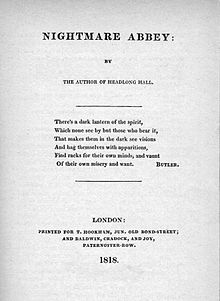Nightmare Abbey

Title page of the first edition (1818)
|
|
| Author | Thomas Love Peacock |
|---|---|
| Country | United Kingdom |
| Language | English |
| Genre | Gothic novella, Romance novella, Satire |
| Published | November 1818, T. Hookham Jr. and Baldwin, Craddock & Joy |
| Media type | Print (hardback & paperback) |
| Preceded by | Melincourt |
| Followed by | Maid Marian |
Nightmare Abbey is an 1818 novella by Thomas Love Peacock, and his third long work of fiction to be published. It was written in late March and June 1818, and published in London in November of the same year by T. Hookham Jr of Old Bond Street and Baldwin, Craddock & Joy of Paternoster Row. The novella was lightly revised by the author in 1837 for republication in Volume 57 of Bentley's Standard Novels.
Nightmare Abbey is a Gothic topical satire in which the author pokes light-hearted fun at the romantic movement in contemporary English literature, in particular its obsession with morbid subjects, misanthropy and transcendental philosophical systems. Most of the characters in the novella are based on historical figures whom Peacock wishes to pillory.
Insofar as Nightmare Abbey may be said to have a plot, it follows the fortunes of Christopher Glowry, Esquire, a morose widower who lives with his only son Scythrop in his semi-dilapidated family mansion Nightmare Abbey, which is situated on a strip of dry land between the sea and the fens in Lincolnshire.
Mr Glowry is a melancholy gentleman who likes to surround himself with servants with long faces or dismal names such as Raven, Graves or Deathshead. The few visitors he welcomes to his home are mostly of a similar cast of mind: Mr Flosky, a transcendental philosopher; Mr Toobad, a Manichaean Millenarian; Mr Listless, Scythrop's languid and world-weary college friend; and Mr Cypress, a misanthropic poet. The only exception is the sanguine Mr Hilary, who, as Mr Glowry's brother-in-law, is obliged to visit the abbey from family interests. The Reverend Mr Larynx, the vicar of nearby Claydyke, readily adapts himself to whatever company he is in.
Scythrop is recovering from a love affair which ended badly when Mr Glowry and the young woman's father quarrelled over terms and broke off the proposed match. To distract himself Scythrop takes up the study of German romantic literature and transcendental metaphysics. With a penchant for melancholy, gothic mystery and abstruse Kantian metaphysics, Scythrop throws himself into a quixotic mission of reforming the world and regenerating the human species, and dreams up various schemes to achieve these ends. Most of these involve secret societies of Illuminati. He writes a suitably impenetrable treatise on the subject, which only sells seven copies. But Scythrop is not despondent. Seven is a mystical number and he determines to seek out his readers and make of them seven golden candlesticks with which to illuminate the world. He has a hidden chamber constructed in his gloomy tower as a secret retreat from the enemies of mankind, who will no doubt seek to thwart his attempts at social regeneration.
...
Wikipedia
